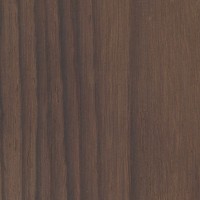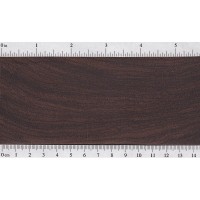 |
Common Name(s): East Indian Rosewood, Indian Rosewood, sonokeling Scientific Name: Dalbergia latifolia Distribution: India, Sri Lanka, and Indonesia Tree Size: 100 ft (30 m) tall, 2-4 ft (.6-1.2 m) trunk diameter Average Dried Weight: 52 lbs/ft3 (830 kg/m3) Specific Gravity (Basic, 12% MC): .70, .83 Janka Hardness: 2,440 lbf (10,870 N) Modulus of Rupture: 16,590 lbf/in2 (114.4 MPa) Elastic Modulus: 1,668,000 lbf/in2 (11.50 GPa) Crushing Strength: 8,660 lbf/in2 (59.7 MPa) Shrinkage: Radial: 2.7%, Tangential: 5.9%, Volumetric: 8.5%, T/R Ratio: 2.2 |
Color/Appearance: Heartwood of East Indian Rosewood can vary from a golden brown to a deep purplish brown, with darker brown streaks. The wood darkens with age, usually becoming a deep brown.
Grain/Texture: Has a medium texture and fairly small pores. The grain is usually narrowly interlocked.
Endgrain: Diffuse-porous; medium to large pores in no specific arrangement, very few to few; solitary and radial multiples of 2-3; heartwood deposits (dark brown) occasionally present; narrow rays not visible without lens, normal to fairly close spacing; parenchyma banded, vasicentric, lozenge, winged, and confluent.
Rot Resistance: Rated as very durable and resistant to termite attack.
Workability: East Indian Rosewood can be difficult to work with tools because of its interlocked grain and density. The wood can sometimes contain chalky deposits that will rapidly dull cutting edges. Glues and finishes well, though color from the wood’s natural resins can inadvertently bleed onto surrounding surfaces when applying a finish, so care must be taken on the initial seal coats.
Odor: Has a distinct, rose-like scent when being worked; some find its scent less pleasant than other Dalbergia rosewoods.
Allergies/Toxicity: Although severe reactions are somewhat uncommon, East Indian Rosewood has been reported as a sensitizer. Usually the most common reaction is skin irritation. See the articles Wood Allergies and Toxicity and Wood Dust Safety for more information.
Pricing/Availability: Generally good availability in both board and turning blank form. Expect prices to be high for an imported hardwood, though not as prohibitively high as some of the scarcer rosewoods.
Sustainability: East Indian Rosewood is listed on CITES appendix II under the genus-wide restriction on all Dalbergia species—which also includes finished products made of the wood. It is also listed on the IUCN Red List as vulnerable due to a population reduction of over 20% in the past three generations, caused by a decline in its natural range, and exploitation.
Common Uses: Fine furniture, musical instruments, veneer, turned and other specialty wood objects.
Comments: East Indian Rosewood has been used extensively on acoustic guitars since the mid 1960s as a substitute for the now-endangered Brazilian Rosewood.
- African Blackwood (Dalbergia melanoxylon)
- Amazon Rosewood (Dalbergia spruceana)
- Bois de Rose (Dalbergia maritima)
- Brazilian Rosewood (Dalbergia nigra)
- Burmese Blackwood (Dalbergia cultrata)
- Burmese Rosewood (Dalbergia oliveri)
- Cocobolo (Dalbergia retusa)
- Honduran Rosewood (Dalbergia stevensonii)
- Kingwood (Dalbergia cearensis)
- Madagascar Rosewood (Dalbergia baronii)
- Siamese Rosewood (Dalbergia cochinchinensis)
- Sissoo (Dalbergia sissoo)
- Tulipwood (Dalbergia decipularis)
- Yucatan Rosewood (Dalbergia tucurensis)
Scans/Pictures: A special thanks to Steve Earis for providing the wood sample (endgrain) and turned photo of this wood species.









I’ve used this rosewood for small turning projects like wine bottle stoppers and pens with fine results; besides, i’m a fan of most rosewoods as they do have a distinctive pleasant odor which makes the experience using it all the better!
If you’re considering this wood for furniture, please try another species. This is one of a few tropical hardwoods prized by musical instrument makes. We cringe when we see a hundred guitars turned into a footstool. Thanks.
Speaking as a luthier, this is one of the reasons I’d like to see the industry embrace domestic hardwoods. Tougher to sell because of a century of bias but I believe a world class sounding guitar can certainly be built from oak or black locust or any number of trees growing in our back yard.
I’m surrounded by this stuff. In the 1980s, we bought Chinese rosewood furniture like it was going out of style. Cheap hinges and clasps. Cheap glue. (I actually got out of a king chair in a showroom and had the entire arm structure pop out.) But the wood and workmanship were superb. Forty years later, the desk I’m typing still holds the same beautiful blacks, reds, and orange hues will little darkening over the years. The rust-orange is similar to quarter sawn Sapele after it darkens. But East Indian Rosewood finishes much smoother unless you meticulously fill the Sapele. All… Read more »
I suppose this is not suitable for making an axe handle/shaft out of. For an axe handle that is to be longer than 20″ it is important that you find a piece with straight grains. But If someone has made tool shafts or anything that has been exposed to mechanical load, please let me know what you have experienced with this wood.
A 6″ bowl in East Indian Rosewood
Does East Indian Rosewood float?
In water, yes.
What about East Indian Rosewood for nunchaku?
I turned a ring made of East Indian Rosewood. Didn’t have any issues with it on the lathe.
How’s that!!!
How is this wood, or other kinds of rosewood, for carving (in terms of holding details and also ease of carving with hand tools)?
Hasan,
I have used East Indian Rosewood for carving and turning but on a machine. I don’t see a problem carving with hand tools, only that the wood is pretty hard to work with. Rest is all fine.
Leonard
crwtblr@gmail.com
Hey Leonard,
Have you used this wood for any straight shafts or similar objects? I am uncertain of whether this will work for an axe handle/shaft. What is important for ax axe shaft is that the grains are as straight as they can be. And that they can run parallel with the axe head/cutting edge. I´ll send you a copy to your email just to be sure you get this question.
I do not think that would be workable, because of the interlocked grain and density, I build a neck for my guitar, it looks great, and sound really beauty, however, let me tell you it was difficult, not to sand, but to carve. And not just difficult but also adding the risk of cracking.
Pd. I am not an english speaker, so, sorry my posible mistakes on writing.
Why is Dalbergia latifolia called East Indian Rosewood? all plantations are on the western side
Here in the United States, the phrase “East Indian” is usually used to distinguish it from the more generic term “Indian” — which is more ambiguous and can sometimes simply mean “native American” and may refer to indigenous peoples found in the Americas. The “East” is added to specify “Indian” in terms of Asia versus America.
I’m sorry to announce,
As of January, 2017, East Indian Rosewood, like most of our treasured Rosewoods, has been stamped onto the list of restricted woods for exportation by the Indian Government. Gone now are yet two more of these valuable woods: East Indian Rosewood and Sissoo.
Does this wood have a sparkle in the sun? I came across some wood from Indonesia sold as rot resistant plant stakes in 3/4″ square 6-foot stakes which works beautifully as xylophone keys. It is loud and has a nice long sustain when rung compared to: -two different samples of what I thought to be Brazilian Rosewood that I bought 35 years ago -African Sapele which has a quite usable tone -Cedar is actually pretty bright and loud if coarse and tinny and it’s popular for guitar soundboards -Redwood is similar to Cedar -English Yew stunk -Doug Fir useless -Purpleheart… Read more »
East Indian Rosewood was uncomplicated to work with however, I noticed a red rash on the insides of my wrists and forearms.
I now use gloves and long sleeves when sanding with this wood.